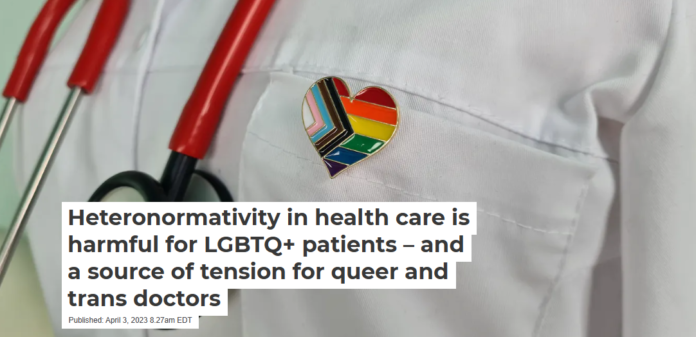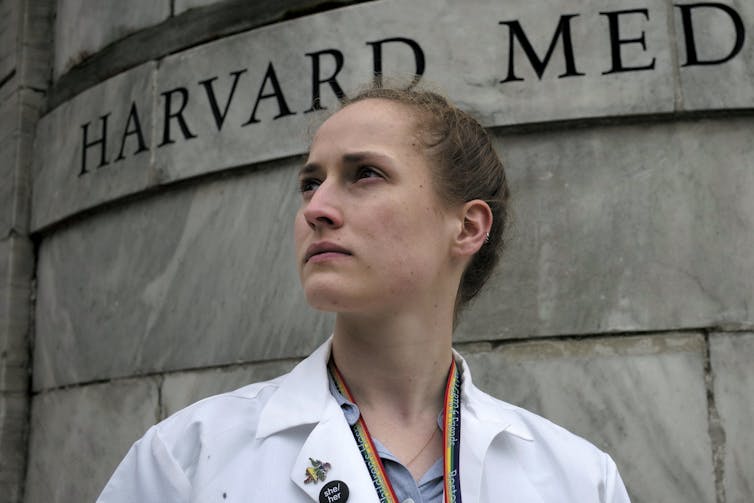

William Robertson, University of Memphis
Members of the lesbian, gay, bisexual, transgender and queer community have long experienced prejudice in medical settings. This can range from microaggressions, such as comments that a patient doesn’t “look” queer or trans, to outright discrimination like denial of care. Combined with living in a society where LGBTQ+ people are routinely subjected to discrimination and bigotry, many patients choose not to disclose their sexual or gender identities to medical providers or not to seek care at all.
Even among medical providers who practice some form of cultural competency – an awareness of and respect for differences across cultures – and are accepting of LGBTQ+ patients, unconscious biases can shape how they understand and talk to and about LGBTQ+ patients and issues. No one leaves their cultural baggage at the clinic door.
I am a medical anthropologist who researches LGBTQ+ health and health disparities. I have paid special attention over the past decade to how a particular kind of bias called heteronormativity shapes how health care providers deliver care and practice medicine.
What is heteronormativity?
Heteronormativity refers to a cultural bias that presumes heterosexuality is the natural and normal default state of all people. Under this worldview, cisgender male and female bodies are treated as complementary opposites that are “meant” to fit together. Heteronormativity is pervasive in contemporary societies and is easily visible in social norms about gender relations, gender roles, sexual attraction and kinship and family.
An example of heteronormativity I have personally experienced in multiple settings is being asked if I have a wife. That question is heteronormative because it presumes the person is heterosexual and requires them to “come out” as not being straight to correct the bias.
Deviations from heterosexuality have historically been considered pathological. Homosexuality was removed from the list of diagnostic mental illness categories only in the 1970s. Despite that change, some contemporary conservative discourses continue to pathologize LGBTQ+ people as dangerous and abnormal and consider the heterosexual nuclear family as the ideal social arrangement. This perspective is known as heterosexism.
While heteronormativity is largely implicit and unconscious, heterosexism is explicit and considers heterosexuality to be morally superior. Heteronormativity might involve asking questions that assume a patient is heterosexual, but heterosexism would deny patients care altogether.

Homophobia – a disgust, hatred or prejudice toward queer people – often stems from heteronormativity or heterosexism. Sometimes homophobia is unintentional, and people don’t immediately recognize that something they said or did is homophobic. Other times, people deliberately intend to express bigotry.
Like other forms of prejudice such as racism and ableism, people are socialized into homophobia, heteronormativity and heterosexism. Even members of the groups that are being targeted and marginalized with these forms of prejudice can internalize them. When these cultural norms and values are internalized, they become biases like heteronormativity.
Heteronormativity in health care
Cultural norms and values, of which heteronormativity is one, are deeply ingrained and form personal and societal worldviews. These attitudes shape individuals’ thought and behavior and social institutions such as health care. So it is unsurprising that heteronormative biases are just as pervasive in medical settings as they are in other areas of society.
Since at least the late 1990s, movements have sought to encourage medical practitioners to be more attentive to the diversity of their patient populations, including LGBTQ+ people. People identifying as members of the LGBTQ+ community are increasingly coming out in medical education settings, though they often continue to experience heterosexism, homophobia and transphobia. Nonetheless, LGBTQ+ medical students and practitioners are often at the forefront of working for positive changes in order to improve health care for LGBTQ+ people.

However, integrating their personal and professional identities can be challenging. Medical students develop identities as physicians with clear moral boundaries separating them from patients through a process called professionalization. My work with LGBTQ+ medical students has found that their experiences of heteronormativity and heterosexism did not seem to overcome the professionalization they underwent in medical school. Instead, they experienced a friction between their LGBTQ+ experiences and their budding identities as “neutral” and “objective” clinicians. In other words, medical education isolated their sense of who they are as doctors from their sense of who they are as queer and/or trans.
I refer to the ways medical students talked about this tension as an “irrelevance narrative.” They would explain how their queer identities were central to their lived experiences and interactions with people except when it came to delivering care to patients, in which case their queerness was deemed “irrelevant.” This was despite the fact that they had all experienced heteronormativity and heterosexism both in and out of medical settings, which clearly indicates that their queerness is very much a part of their professional environment.
I saw the irrelevance narrative as a fascinating example of how medical professionalization can force a disconnect between personal identity and professional identity for people in marginalized communities. Paradoxically, this separation works to uphold heteronormativity in medical environments. In a field that treats cisgender heterosexuality as a neutral default, students come to see their own queerness as a nonneutral factor that needs to be ignored in order to be professional, leaving those heteronormative biases unchallenged.
Holistic health care for all
Professionalism that sets a boundary between the personal and professional is vitally important for clinical work because it enables treatment and safety standards that can improve health outcomes. But medicine is more than just diagnosing and treating disease. It is as much a social and cultural science as it is a biological one.
Training medical providers to engage in what anthropologists call a holistic approach, which considers each patient as a person with life contexts that play an important role in care, could help providers better understand their patients’ needs. Taking social and cultural factors into account can lead to better and more effective treatment plans.
This kind of educational reform is already underway. For example, the Medical College Admission Test was updated in 2015 to incorporate a major section on social science. Still, much work remains to be done.
Medical providers must also do the hard work of recognizing how their own cultural baggage, social norms and biases profoundly shape their ability to care for patients. This is especially true when treating patients from populations that have historically been mistreated and ignored both in medicine and broader society. Making assumptions about who patients are or what they need, regardless of intention, can make medical settings uncomfortable or even hostile.
To achieve a happier, healthier society, everyone must feel comfortable seeking care when they need it. This requires medical environments to become actively affirming spaces where LGBTQ+ people can feel comfortable being open about who they are and raise health concerns without fear of judgment, ridicule or bigotry. Merely avoiding being openly prejudiced isn’t enough.
William Robertson, Assistant Professor of Anthropology, University of Memphis
This article is republished from The Conversation under a Creative Commons license. Read the original article.



















